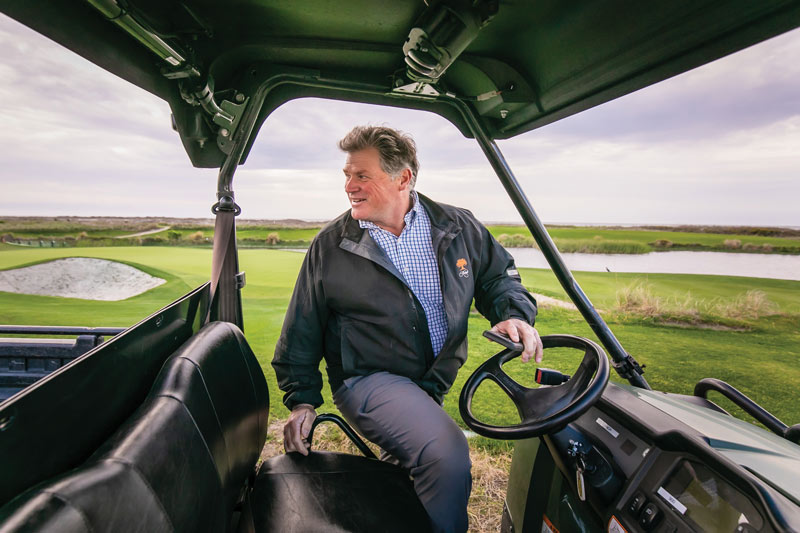
Superintendent at Kiawah Island (S.C.) Golf Resort’s Ocean Course since 2003, Jeff Stone and his staff will welcome the course’s second PGA Championship May 20-23. Photo by Leslie McKellar
It wouldn’t be difficult to find a golf course with the same kind of rich history that stretches out behind the Ocean Course at Kiawah Island (S.C.) Golf Resort.
But good luck finding one that has seen so much in so little time.
The year it opened, 1991, the Ocean Course hosted the Ryder Cup, a spirited battle dubbed the “War by the Shore.” Since then, it has hosted Shell’s Wonderful World of Golf (1996), the World Cup of Golf twice (1997 and 2003), the PGA Club Professional Championship (2005) and the Senior PGA Championship (2007). The Ocean Course hosted the 2012 PGA Championship, which Rory McIlroy won by a record eight strokes, and this month, the PGA Championship will return.
And that’s just the big-name events held there.
Heck, the Ocean Course was making waves before it even opened, like when it was announced two years before the course was built that the event-redefining ’91 Ryder Cup would be played there, or when devastating Hurricane Hugo roared through, complicating an already tight construction timeline and forcing famed architects Pete and Alice Dye and their crew to access the area by boat.
Perhaps it’d be best to say the place has a flair for the dramatic.
“Name one course that has that kind of history,” says George Frye Jr., the course’s first superintendent. “You can talk about (Pinehurst’s) Course No. 2. It’s 100 years old. You can talk about Pebble Beach. But name another course of this age that has had this much drama, this much history, this much tournament exposure, all in, what, 30 years?”
Whistling Straits — coincidentally, site of this year’s postponed-from-2020 Ryder Cup, and another Dye design — might like a word. But Frye makes a compelling argument.
And then there’s this: The Ocean Course is so picturesque, so idyllic, it served as backdrop for much of the Will Smith-Matt Damon-Charlize Theron movie “The Legend of Bagger Vance,” filmed by Robert Redford in 1999.
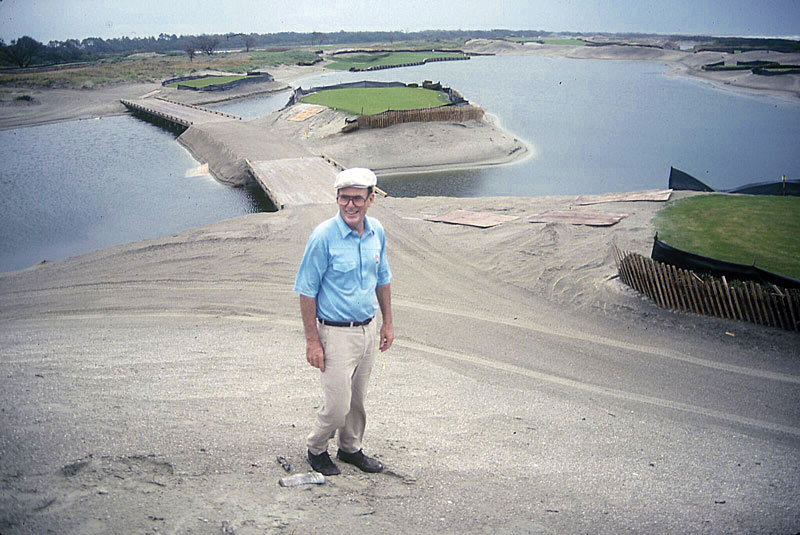
Pete Dye designed the Ocean Course with his wife, Alice, specifically to host the 1991 Ryder Cup, which came to be known as the “War by the Shore.” Photo courtesy of Scot Sherman
While some golf courses are immortalized in sepia-toned black-and-whites, the Ocean Course’s history is mostly filmed in Technicolor — even if it doesn’t play on current superintendent Jeff Stone’s screen.
“I don’t know about that,” Stone, a 26-year GCSAA member who has spent nearly all of his turf career on Kiawah Island, says about his former boss’s declaration about the track’s place among golf’s wunderkinder. “I’m sure there are golf courses out there that have had quite a few events like that. In all reality, I have so much going on, I don’t really have the opportunity to see what’s going on at other places. The Ocean Course in particular is always going to be at the forefront of trying to get major tournaments, always having some event, whether it’s televised or not. It’s a special place. It’s ... pretty dynamic.”
‘You don’t control the golf course’
Stone’s word choice is particularly apt.
While all golf courses are the sum of their organisms, from the smallest microbes to the tallest tree and everything between, the Ocean Course acts almost like an organism itself. All golf courses grow; the Ocean Course moves.
Pete Dye famously — poetically, evocatively — said the course “walks,” and Stone is among those who have to sidle up alongside, wrap an arm around its shoulder and tenderly redirect it back to where it came.
“The biggest challenge for someone in my position at this golf course — and I watched George manage out here, and I learned from his successes and his mistakes — but, out here, you don’t control the golf course,” Stone says. “You work with what Mother Nature is doing to your golf course. You can’t control it. If you try to control it, it’ll drive you crazy. Mother Nature really changes this golf course every day. How this golf course changes in one year takes other golf courses five to seven years to change that much. It’s Mother Nature doing it, and she’s doing it 24/7.”
Connor Carlisle had heard the stories. Carlisle, an Arkansan who studied golf and sports turf management at Mississippi State University, had vacationed as a child in nearby Charleston and Myrtle Beach, S.C. He liked the area and hoped to work there.
After a couple of internships, including three months at Kiawah, he was hired as second assistant at the Ocean Course right out of school, in February 2019.
“This course is so unique,” says Carlisle, a five-year GCSAA member. “That statement about how the course ‘walks’ is so true. Jeff says it, but when you see it, it all just seems so true. You come out one day, and this dune has just ... shifted.”
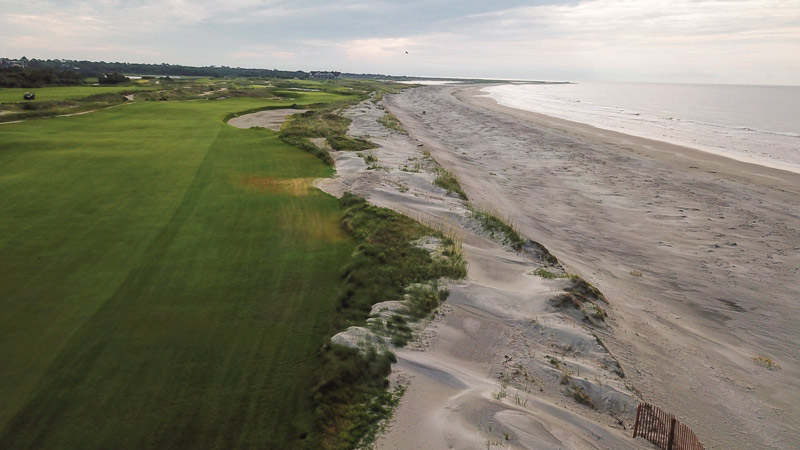
A drone view shows the beach trying to reclaim part of the Ocean Course. Photo by Jeff Stone
Some superintendents might plan the next day’s maintenance work before calling it a day. Stone doesn’t bother.
“You wake up that day, you might come out and find where the wind was blowing 30 mph and you’ve got 1,000 yards of sand covering 16 fairway or tee,” Stone says, “or there’s a high tide and you have to deal with a water issue. That’s part of it. That’s what this golf course is. The sooner I accepted that and just dealt with it, instead of trying to control it, I was a much happier person and a much happier golf course superintendent.”
Stone started his turfgrass career in his hometown of New Smyrna Beach, Fla., then headed to Lake City (Fla.) Community College (now Florida Gateway College). His first internship was with Tim Hiers, CGCS, a 42-year GCSAA member, at John’s Island Club in Vero Beach, Fla. His second internship was with Frye, a 37-year member, at Kiawah Resort.
“I just fell in love with the area,” says Stone, who, upon graduation in 1990, accepted Frye’s offer to join the Kiawah staff as an assistant. “I’ve been very fortunate to have spent 99.9% of my career here.”
‘You don’t plan anything. It plans you.’
All those dramatic moments in the Ocean Course’s brief history? Stone was there for each of them, whether as an intern (construction), assistant (The Ryder Cup, Shell’s event, the first World Cup) or superintendent (everything since 2003). He makes no effort to disguise how much he relies on Frye.
“What a great mentor to work with,” Stone says. “He’s great to have on the island.”
Frye, who still consults on behalf of his company, TransGolf Inc., when his health allows, wrote the book — literally — on the Ocean Course. He authored and presented on “Best Management Practices at the Ocean Course” and says now that was an exercise born of youthful optimism and hubris.
“I’ve been around golf a long time, and I’ve never seen a golf course quite like the Ocean Course,” Frye says.
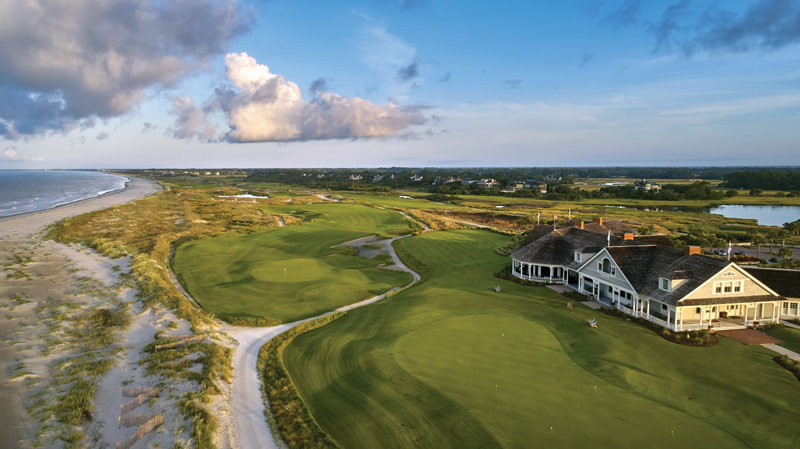
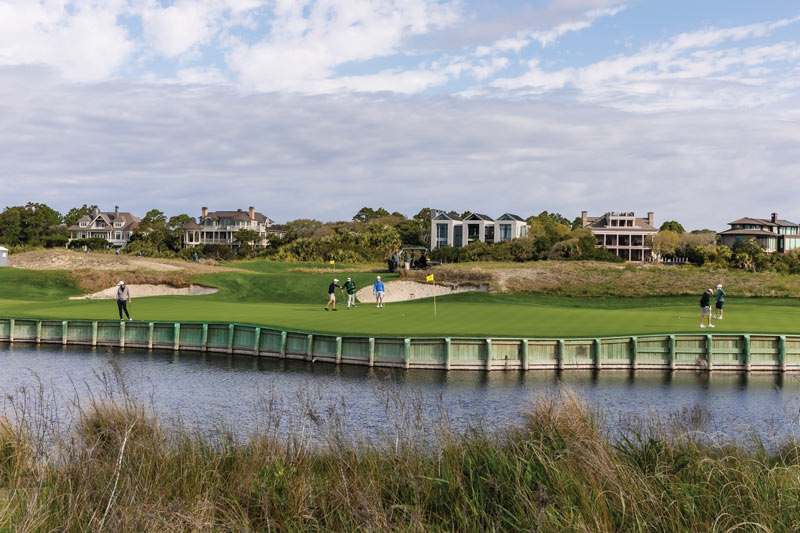
The Ocean Course has been major host, movie setting and many a golfer’s woe. Photos by Leslie McKellar
The defining characteristics obviously include the elements, like the relentless winds, the Atlantic Ocean, which is visible from every hole, and, crucially, the turfgrass — or lack thereof.
“Fifty percent of that golf course is non-turf,” Frye says. “I’ve played golf everywhere. Other places have dunes. Other courses have the ocean. You go to St. Andrews, they’ve got gorse lining the fairways, heather in spots. You go to Pebble (Beach), they have the ocean, but they’ve got turf. That grass and vegetation stabilizes everything. Here, you don’t have that anchor, and sometimes you’re just trying to keep the environment from overtaking the little part that is anchored, and you have to adjust to that. You take other golf courses, the superintendents can plan their day — you have to mow the rough, rake the bunkers. That’s not how this golf course works. You don’t plan anything. It plans you.
“I don’t spend a lot of time missing it. I do enjoy riding around with Jeff. But I tell him, ‘This makes me tired just looking at it.’”
Enjoying the tournament-prep process
Preparation for his second PGA Championship at the Ocean Course has had the opposite effect on Stone and his staff.
“I was talking with George about that just yesterday,” Stone says. “The first go-around was pretty hectic. This go-around, honestly, I’m enjoying the process much more. We all face challenges every day. But I made the commitment to embrace the challenge, to see it as an opportunity to do something different, better than what we were doing. I made a commitment to myself and the guys to enjoy the whole process.
“This tournament might be the greatest success, and if it is, fantastic. If something happens, I know I did the best I could.”
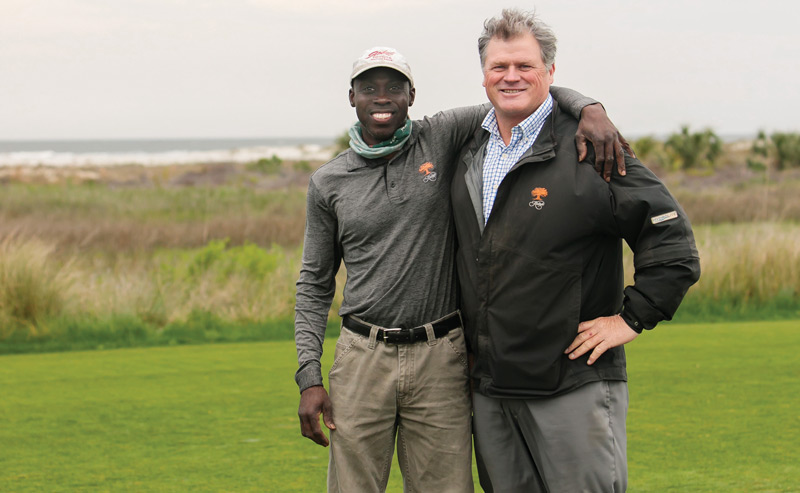
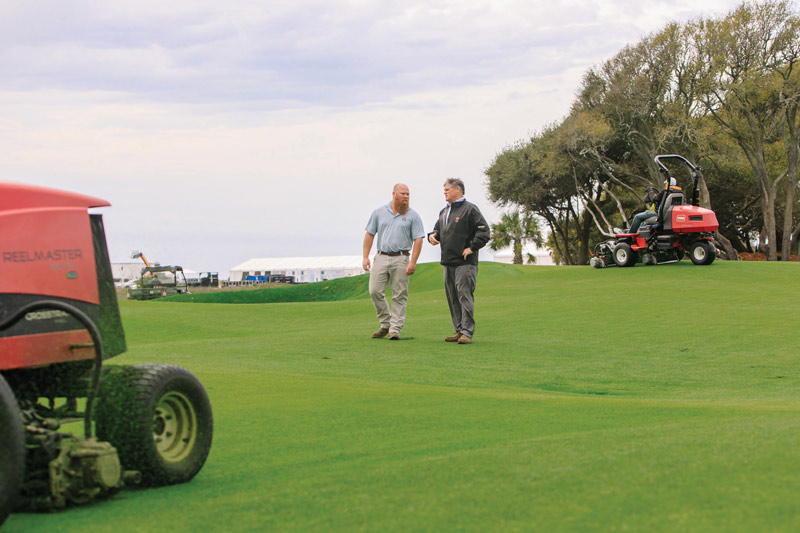
Superintendent Jeff Stone (on right in both photos) with Kiawah Island Golf Resort horticulturist Steven Gadsden (top) and senior equipment technician Chris Sires (bottom). Photos by Leslie McKellar
One notable change to the preparation is the season. The 2012 PGA Championship was held in early August. This year, it runs May 20-23.
“The turf and everything will be the same,” Stone says. “The golf course is the same. The fairway lines are a little different, and the rough heights are a little different. Hopefully there may be some cooler temperatures and more wind than in August.
“Agronomically, we won’t have the whole summer to really get the golf course set up and ready to play. That being said, it’s a little bit easier agronomically (in August). We don’t have that transition issue with our overseed.”
The Ocean Course was originally grassed with TifEagle bermudagrass greens and approaches, and Tifway 419 bermudagrass on fairways and tees. As a concession to the environment and the briny water available for irrigation, the course regrassed greens with paspalum in 2003 — the 2012 PGA Championship was the first major to be played on it — and eventually integrated it throughout the course.
“It was a water issue,” Frye says. “The golf course probably bounced around a lot more back then. When it rained, the golf course would shine. When it didn’t rain, you could see the effects of bad water a lot more.”
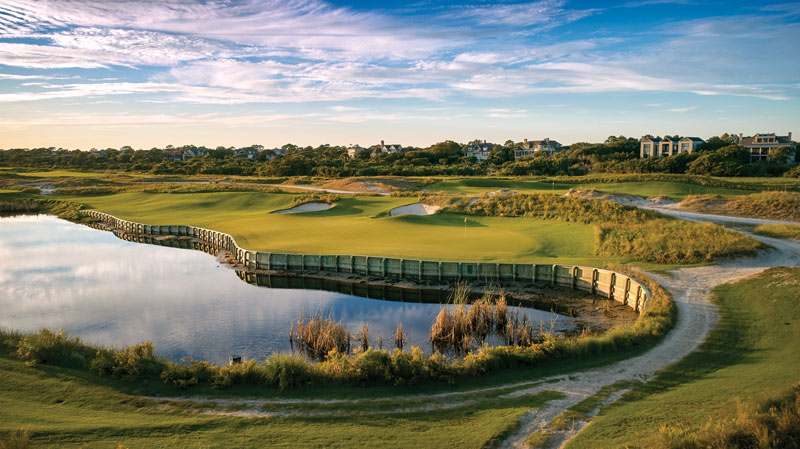
The 2012 PGA Championship on the Ocean Course was the first major to be played on paspalum. Photo by Leslie McKellar
In mid-April 2021, despite an unusually frosty winter, Stone said the course was “right where it should be” in preparation for the PGA Championship.
“We’re starting to get good weather. It’s starting to warm up, and our summer grasses are starting to green up,” he says. “We did overseed bentgrass, but for the tournament, we should have predominantly paspalum greens. We overseed wall to wall here anyway. The only caveat is watching our fertility, getting the rough thicker. That’s not something we normally do. For us to have the rough here at the heights we want to have, we have to have that ryegrass. There’s no way to get 3 inches of bermuda in May.”
‘Nowhere to hide’
The Ocean Course of the 2021 PGA Championship isn’t fundamentally different from the course of nine years ago, though the staff did perform what it calls “maintenance” two years ago.
Remember how the course walks and shifts and squirms? Stone says all tees were laser-leveled and regrassed. A couple of tees were added; bulkheads were replaced; a few dozen yards, perhaps, were added just in case the wind isn’t blowing and length is needed. PGA Championship director Scott Reid characterized the changes as small, noting most of the lengthening tweaks were to the par 4s and that the course could be played as long as nearly 8,000 yards.
Stone doesn’t think that will be necessary.
“The biggest defense of this golf course is going to be the wind,” Stone says. “As far as making it tougher, it is what it is. As far as these guys hit it ... well, they’d better hit it online. If you’re offline here, it’s pretty tough once you’re in the dunes. The biggest thing is the routing, the location. These guys see phenomenal golf courses every week. But the location of being right on the ocean, there’s nothing there. You’re at the mercy of Mother Nature. If the wind blows, there’s nowhere to hide.”
Architect Scot Sherman concurs.
Sherman, who first met the Dyes at Kiawah in 1989, helped consult on the recent maintenance project. Part of that entailed referring to aerial photos of the course when it was first constructed and during the 1991 Ryder Cup. Flipping through those photos, Sherman says, was a delightful trip down memory lane — and a reminder of the Dyes’ genius.
“Professionally, that golf course, when you look at it from an aerial view, you can see Pete’s ‘S’ shapes — regular-shaped S’s, backwards S’s, that strategic S of his — to make sure players can work the ball in both directions,” Sherman says. “There’s S’s all over that course. It’s so apparent.”
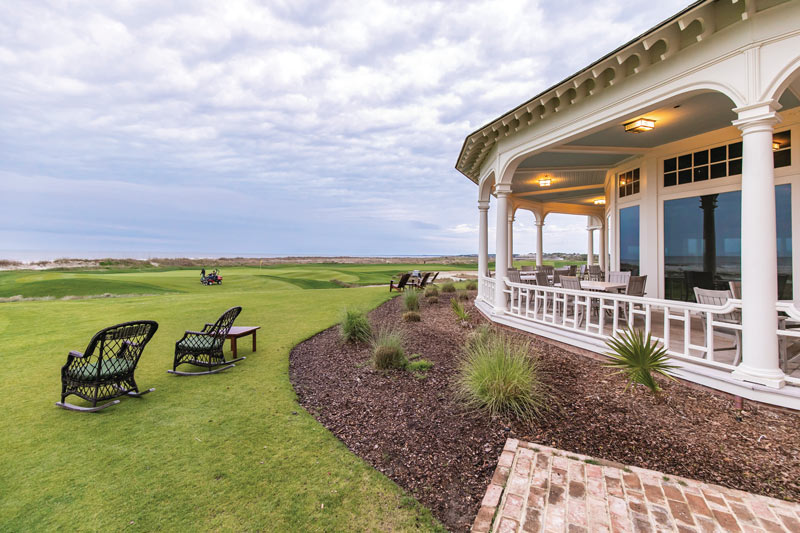
The veranda of Kiawah Island Golf Resort’s Ryder Cup Bar. Photo by Leslie McKellar
Pete Dye died in January of last year, 342 days after Alice passed away.
“I’m extremely excited — now that Pete and Alice have passed — I’m excited the world can see once again one of their great golf courses,” Sherman says. “There are 20-year-old kids who love golf or golf courses or golf course architecture who maybe have never seen this golf course, and maybe they’ll be inspired to play golf or work in golf. I’m excited for the Dye family tree to be spread out just a little bit more. You know, their tree goes a long, long way.”
Sherman is confident Stone and his crew will have the course looking and playing its best, and he assures that no matter how hard the wind blows, golf’s best will be challenged.
“Regardless of the weather,” Sherman says, “Pete’s course is going to have teeth.”
Gallery a go at the 2021 PGA Championship
No fans were permitted for the 102nd PGA Championship played last year at TPC Harding Park in San Francisco, just one of many precautions taken in the face of the constantly evolving — and far from over — coronavirus pandemic.
A few thousand fans are expected for the 103rd edition of the PGA at the Ocean Course at Kiawah Island Golf Resort this month. In February, the PGA of America announced it would allow 10,000 fans per day at the PGA Championship.
“I’m not sure what the final numbers will be,” says Jeff Stone, Ocean Course superintendent since 2003 and a 26-year GCSAA member. “We’re not doing bleachers out here. I know that.”
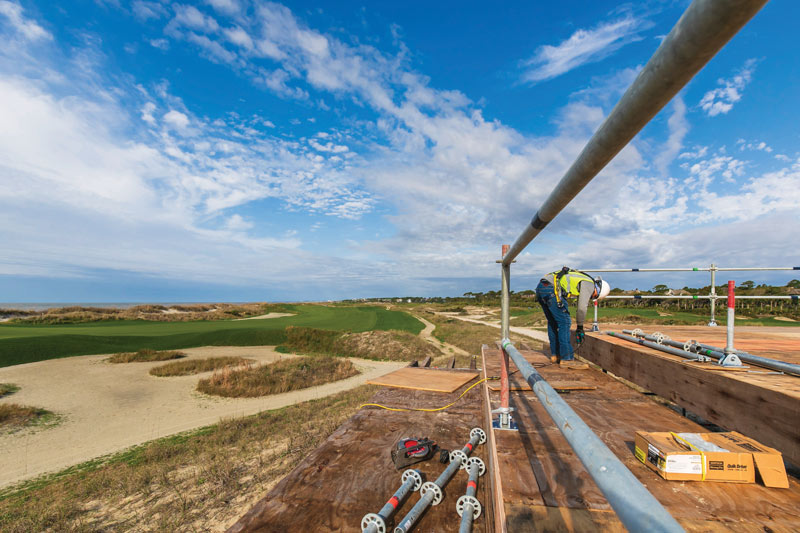
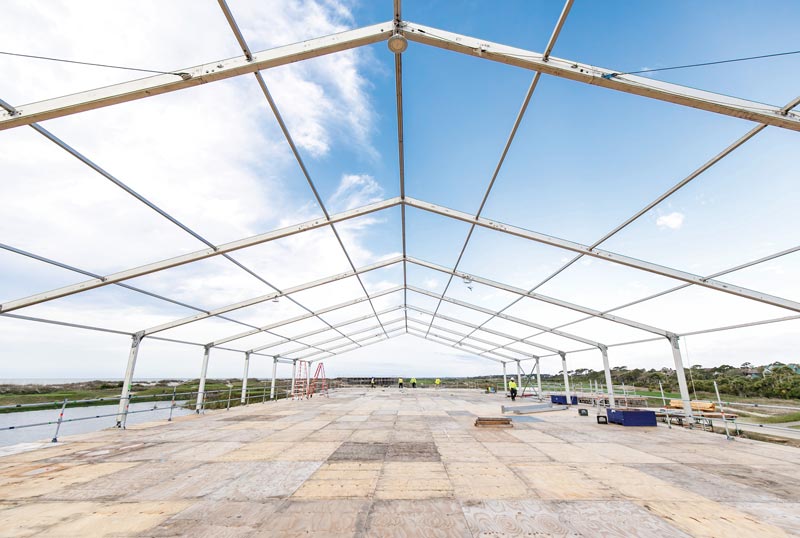
Although there will be tournament infrastructure on and around the Ocean Course, there will be no spectator grandstands, and attendance will be capped at 10,000 per day. Photos by Leslie McKellar
Like many golf course crews, the staff at Kiawah Island Golf Resort has in general shrunk throughout the years.
“It has gotten a little bit smaller. The boss tells me it’s because we keep getting better at what we do,” Stone says with a laugh.
He says his full-time staff is about 13. That will increase to about 100 for the tournament, including 60 volunteers. Stone will fortify with staff from the resort’s other four courses.
“We’re fortunate we have four other golf courses to utilize — people and expertise,” he says.
Connor Carlisle, second assistant at the Ocean Course and a five-year member of GCSAA, has worked for Stone at the Ocean Course since February 2019. He volunteered for one previous PGA Tour event — the Sanderson Farms Championship, held at the Country Club of Jackson (Miss.) — but that pales to the scope of an event like the PGA Championship.
“This is always something you want as soon as you get into this career,” Carlisle says. “It’s something I’ve always wanted to do, to be part of something like this. I can’t wait.”
The 2021 PGA Championship: Golf course facts
The grass
Greens: Seashore paspalum maintained at .090 inch
Tees: Seashore paspalum maintained at .250 inch
Fairways: Seashore paspalum maintained at .300 inch
Rough: Tifway 419 bermudagrass overseeded with ryegrass, maintained at 3.5 inches
The course
Year built: 1991
Architect: Pete and Alice Dye
Average green size: 6,000 square feet
Acres of fairway: 28
Acres of rough: 53
Number of sand bunkers: 30 acres of sand; no bunkers
Number of holes on which water is in play: 6
Soil conditions: Native beach sand
Water sources: Deep well and reclaimed irrigation runoff
Par: 36-36—72
Yardage: 7,876 (unofficial)
Andrew Hartsock is GCM’s managing editor.